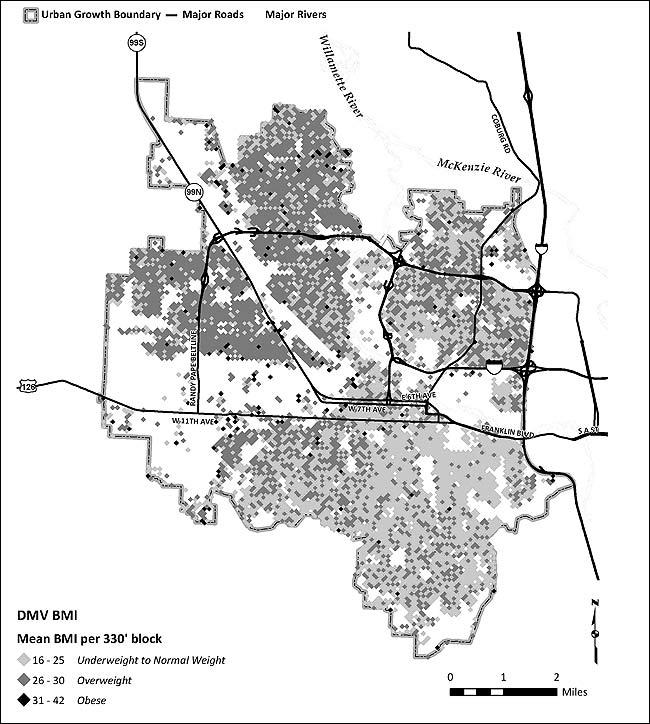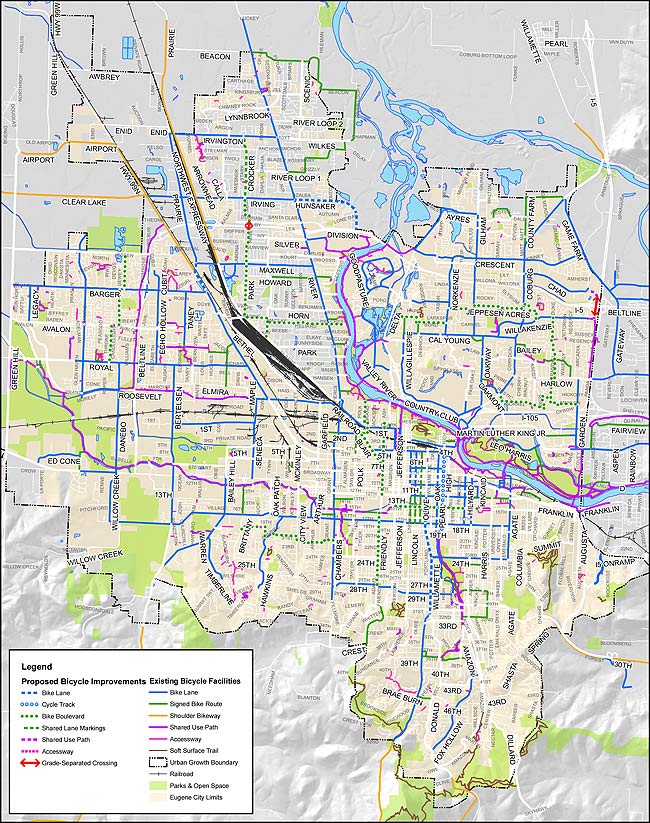Eugene Weekly‘s Bike Issue:
Bike Plan Wobbles Along
Cycling advocates say draft needs pumping up
More Bike Parking
The draft Eugene Pedestrian and Bicycle Master Plan has proposed increased bike parking requirements.
Kickin It Down the Road
The alternative to alternative transport
Bike Plan Wobbles Along
Cycling advocates say draft needs pumping up
By Alan Pittmanû
The city of Eugene is moving forward with a draft plan that envisions doubling cycling in 20 years with bike lanes on south Willamette Street, a separated cycle track on High Street, a bridge over Beltline and miles of øbike boulevards.”û
But many other important bike projects are missing and the draft has disappointed many in the bike community who say they fear that it lacks teeth to actually make the big shift to the greener, healthier, more livable and cheaper mode of transportation.
øIm very disappointed in the plan,” said Fred Tepfer, a UO planner involved in bike advocacy for decades in Eugene. The proposed new policies are øweak” and øasleep,” he said at a meeting of the citys Bicycle and Pedestrian Advisory Committee (BPAC) last week. øBusiness as usual could fit very well into the goals that are stated.”
øI think this plan has got to have teeth in it,” said BPAC member Judi Horstmann. If the City Council decides to remove tough policies, øthen we can fight there,” she said.
The bike plan, the large part of the citys new Eugene Pedestrian and Bicycle Master Plan, has already generated record citizen interest with more than 900 comments during its development this spring. The early draft of the plan will go out for public comment this month and is expected to be finalized with City Council approval by the end of the year.
But despite citizen enthusiasm for the issue, Eugenes draft plan comes across flat by comparison to Portlands. That citys new bike plan touts the social, environmental and economic benefits of quadrupling biking in the city. øYou just cant get a better transportation return on your investment than you get with promoting bicycling,” the plan quotes Portland Mayor Sam Adams.û
But Eugenes dryly worded plan contains only vague proposed policies that largely correspond to existing city policies without calling for measurable increases in city efforts and results to increase cycling.û
The draft plan states that doubling bike trips by 2031 is a øvision,” but it doesnt say whether its a city policy. Nor does it say how to measure bike trips. Eugene now has a bike commute mode share of 11 percent, the highest percentage for a city of its size or larger in the nation, according to the U.S. Census.û
The plan doesnt explicitly state that the citys policy is to double that number to 22 percent in two decades, still well below many cities in Europe now. Nor does the plan state an interim 2021 goal of a 50 percent increase.
Theres a call for reduced bike theft, but no measurement of by what percentage. In the past, Eugene has been rated by Kryptonite as one of the worst cities in the nation for bike theft. Nor does the plan call for actual increased police efforts or new laws to reduce theft.
The plan calls for developing programs to shift from driving to biking, but it doesnt say how. New York and cities in Europe are now pursuing policies to make driving and parking more difficult and expensive to encourage alternative modes like biking. Portlands new bike plan calls for ømaking bicycling more attractive than driving for short trips.”û
øWe dont have disincentives” in the plan, Eugene transportation planner Rob Inerfeld admitted.
øMost transportation system plans would have both” incentives and disincentives, Tepfer said. øIf its just incentives, we never get there.”
øWhats in the plan to get people out of their cars?” agreed BPAC member Harriet Behm.û
Tepfer noted that limiting parking has been an important part of the UOs success in increasing biking and other alternative modes.û
Even the citys old TransPlan from 20 years ago (that the new bike plan is meant to improve) includes policies calling for reducing parking through ømaximum allotments,” paid parking and øincreasing parking fines.”
øThey cant afford it,” said BPAC member David Gizara, of the UOs decision not to provide more parking. Gizara said Eugene also cant afford all the new parking and roads to serve cars. øWe cant afford individual autos anymore. They are bankrupting cities.”
The proposed plan also lacks a hierarchy of modes that would prioritize scarce funding and right-of-way space for increased cycling. øThe UO has had a transportation policy since 1977 that says that,” Tepfer said.û
The plan does not prioritize bicyclist safety over the storage of private vehicles in the public right of way. Parking removal has been a big hurdle to many planned Eugene bike safety projects in the past.
The draft also does not prioritize bicyclist safety over small delays in traffic speeds caused by removing car lanes for bike facilities.û
The plan does not change city policy prioritizing limited flexible federal funds for asphalt maintenance projects over cyclist safety projects.û
The bike plan calls for the city to øobtain stable and diverse resources” for bike projects but doesnt give a dollar amount or a percentage of transportation funding to spend on bikes. Currently, about 2 percent of planned local transportation spending goes to bike projects, well below their 11 percent mode share.û
The draft plan also does not have:
ûÇ A call for measurable decreases in vehicle miles traveled per capita (VMT), unlike the old TransPlan and the state Transportation Planning Rule
Ç A policy of 24 percent of future local transportation funding measures to go to biking to match the citys mode share goal
ûÇ Measurable, specific increases in density and reduced urban sprawl to increase biking. The old TransPlan noted that the citys housing sprawl and lack of density ølimits the effectiveness” of efforts to increase alternative modes.û
Ç A percentage reduction in obesity from active transportation. The city has already mapped obesity using DMV records (see øfat map”) as part of its study of ø20-Minute Neighborhoods” to promote biking and walking.
Ç A policy of increasing cyclist satisfaction with road safety as measured by a question inserted into the citys annual citizen surveyû
Ç A specific total mileage of bike infrastructure to build, nor monitoring of progress toward that goal
Ç A policy of reducing serious and fatal bike crashes by a certain percentage
Ç A calculation of a total bike safety deficit in unbuilt infrastructure similar to the citys much-hyped street repair backlog total and a policy in reducing the safety backlog by a certain percentage over time
Ç A calculation or goal for transportation spending saved by the use of far less costly cycling
Planner Inerfeld admitted the policy section of the draft plan needed work and invited BPAC members to send suggestions. But he said the city may need a øbroader conversation” about disincentives. øWhen we try to ram things through from just one perspective, we get more pushback,” he said.
The proposed plan has a confusing array of sometimes overlapping lists and maps of øproposed,” ørecommended,” øpriority” and øfuture” bike projects.û
It appears that only the small øpriority” list matters much because they øshould be given funding priority” to build during the next 20 years, the plan states. The øfuture” projects øwill be implemented beyond the 20-year planning horizon of this plan,” the document states. Theres nothing on when the many øproposed” or ørecommended” projects will be implemented, if ever.
The priority list (see priority map) includes several key projects that cyclists have been requesting for years, including:û
Ç Willamette Street bike lanes from Donald to 18th Avenue. The city recently obtained a state grant that it could use to study actually adding the safety improvement that has already been in city transportation plans for decades.û
Ç A High Street separated cycle track to connect the Amazon bike trail to the river
Ç An over-crossing of Beltline near North Eugene High Schoolû
The plan also prioritizes a large number of øbicycle boulevards,” including on 15th from Jefferson to the UO, on Friendly, Blair and Monroe streets and many more on residential streets in outlying subdivisions. øOne of this plans primary goals is to create a robust bicycle boulevard network,” the document states.
ûBut its not clear from the plan exactly what the city is committing to build when it says øbicycle boulevard.” The plan says the facility øcan vary greatly,” but states øit is assumed that all bicycle boulevards in Eugene will at a minimum have signs, pavement markings, traffic calming, (if needed to keep vehicle speeds low), and some type of intersection crossing treatments.”
Unlike bike lanes, bike boulevards do not legally dedicate any part of the roadway to bicyclists. They are cheap, but without traffic diverters and ødo not enter except bikes” signs, it can be difficult to say that they offer significant improvement over the already existing low traffic street they are put on. Because they are not built in busy areas, bike boulevards often also do not connect to workplaces and shopping where many cyclists want to go.û
Not included in the draft priority list are a lot of important bike improvements long sought by cycling advocates, including:
Ç Bridge connecting the Fern Ridge Path to Target
Ç Beltline bridge to Bethel
Ç Bike lanes on West 13th, north Willamette Street and Franklin Boulevard
Ç Closing the riverfront path gap between the Autzen (Frohnmayer) and Knickerbocker bike bridges
Ç A bike path or bridge from the river path to the Laurel Hill neighborhood
Ç A railway underpass connecting Alder Street to the river
Ç Improvements to dangerous intersections
Ç Uphill bike lanes on Dillard Road and Lorane Highway
Ç Bike lanes on West 11th and buffered bike lanes and/or a separated cycle track on Coburg Road
Ç A two-way cycletrack on 13th leading into the UO
The priority plan offers only one mile of separated, safe cycle track ‹ considered by many advocates as the best way to increase cycling. A Danish study found that cycle tracks were three to four times more effective at increasing ridership than bike lanes.û
In many ways the proposed 20-year priority list would represent a substantial reduction in bike projects compared to the last 20 years in Eugene. In that period, the city built the DeFazio, I-5 and Delta bike bridges, the Fern Ridge trail and completed a big gap in the riverfront bike system.
Comments from the Eugene City Council last week on the planning project mostly focused on councilors wanting bike facility improvements in their wards. Councilor Pat Farr pressed for better bike connections to downtown and the riverfront trail system. øIts a concern for the people from Bethel.”û
Inerfeld told BPAC that the priority list was based on past spending levels for bike projects. øWe thought we should have a plan thats realistic,” he said. øThe big challenge is getting the funding.” û û û û û û û û û û û û û û û û û û û û û û û û û û û
| Fat Map. Body Mass Index from drivers licenses. |
 |
| Priority Bike Project |
 |